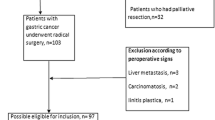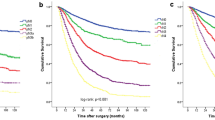Abstract
Background
In gastric cancer, the classification of lymph node status is still a controversial prognostic factor. Recent studies have proposed a new prognostic factor (metastatic lymph node ratio: MLR) for gastric cancer patients who undergo curative resection. The present study tested the hypothesis that MLR was better than the current pN staging system by analyzing the correlation between MLR and the International Union Against Cancer/American Joint Committee on Cancer (UICC/AJCC) staging system, by analyzing the correlation between MLR and 5-year overall survival (OS), by comparing area under the curve (AUC), and by performing univariate and multivariate analyses for OS.
Methods
Of 409 patients who were diagnosed with gastric adenocarcinoma between January 2003 and December 2006, 370 patients underwent curative resection and were included in this study. The prognostic significance of the number of metastatic lymph nodes and the metastatic lymph node ratio were compared in AUC and univariate and multivariate Cox regression analyses.
Results
MLR was significantly correlated with the depth of invasion and the number of lymph node metastases (p < 0.001). Increasing MLR also was statistically correlated with a lower 5-year OS rate (p < 0.001). The AUC of MLR and the number of lymph node metastases were not significantly different (p = 0.825). MLR was an independent prognostic factor on multivariate analysis, but the number of metastatic lymph nodes was not.
Conclusions
MLR can be a prognostic factor in patients who undergo radical resection for gastric cancer and can overcome the limitations of existing prognostic factors.

Similar content being viewed by others
References
Adachi Y, Mori M, Maehara Y et al (1994) Dukes classification: a valid prognostic indicator for gastric cancer. Gut 35:1368–1371
Maruyama K (1987) The most important prognostic factors for gastric cancer patients: a study using univariate and multivariate analyses. Scand J Gastroenterol Suppl 22:63–68
Ohtsu A, Yoshida S, Sajio N (1998) Japanese classification of gastric carcinoma. 2nd English edition. Gastric Cancer 1:10–24
Edge SB, Byrd DR, Compton CC et al (2009) AJCC cancer staging manual, 7th edn. Springer, New York
Sobin LH, Gospodarowicz MK, Wittekind C (2009) TNM classification of malignant tumours, 7th edn. Wiley, Weinheim
Bando E, Yonemura Y, Taniguchi K et al (2002) Outcome of ratio of lymph node metastasis in gastric carcinoma. Ann Surg Oncol 9:775–784
Inoue K, Nakane Y, Iiyama H et al (2002) The superiority of ratio-based lymph node staging in gastric carcinoma. Ann Surg Oncol 9:27–34
Kodera Y, Yamamura Y, Shimizu Y et al (1997) Metastatic gastric lymph node rate is a significant prognostic factor for resectable stage IV stomach cancer. J Am Coll Surg 185:65–69
Takagane A, Terashima M, Abe K et al (1999) Evaluation of the ratio of lymph node metastasis as a prognostic factor in patients with gastric cancer. Gastric Cancer 2:122–128
Hyung WJ, Noh SH, Yoo CH et al (2002) Prognostic significance of metastatic lymph node ratio in T3 gastric cancer. World J Surg 26:323–329. doi:10.1007/s00268-001-0227-9
Fujii K, Isozaki H, Okajima K et al (1999) Clinical evaluation of lymph node metastasis in gastric cancer defined by the fifth edition of the TNM classification in comparison with the Japanese system. Br J Surg 86:685–689
Hayashi H, Ochiai T, Suzuki T et al (2000) Superiority of a new UICC-TNM staging system for gastric carcinoma. Surgery 127:129–135
Feubstein AR, Sosin DM, Wells CK (1985) The Will Rogers phenomenon: stage migration and new diagnostic techniques as a source of misleading statistics for survival in cancer. N Engl J Med 312:1604–1608
Bodner BE (1988) Will Rogers and gastric carcinoma. Arch Surg 123:1023–1024
Cheong JH, Hyung WJ, Shen JG et al (2006) The N ratio predicts recurrens and poor prognosis in patients with node-positive early gastric cancer. Ann Surg Oncol 13:377–385
Santiago JMR, Munoz E, Marti M et al (2005) Metastatic lymph node ratio as a prognostic factor in gastric cancer. Eur J Surg Oncol 31:59–66
Bilici A, Seker M, Ustaalioglu BB et al (2010) Determining of metastatic lymph node ratio in patients who underwent D2 dissection for gastric cancer. Med Oncol 27:975–984
Saito H, Fukumoto Y, Osaki T et al (2008) Prognostic significance of the ratio between metastatic and dissected lymph nodes (n ratio) in patients with advanced gastric cancer. J Surg Oncol 97:132–135
Celen O, Yildirim E, Berberoglu U et al (2007) Prognostic impact of positive lymph node ratio in gastric carcinoma. J Surg Oncol 96:95–101
Liu C, Lu P, Lu Y et al (2007) Clinical implications of metastatic lymph node ratio in gastric cancer. BMC Cancer 7:200
Obuchowski NA (2003) Receiver operating characteristic curves and their use in radiology. Radiology 229:3–8
Zhou XH, Obuchowski NA, McClish DK (2002) Statistical methods in diagnostic medicine. Wiley, New York, pp 15–164
Funding
None.
Conflicts of interest
None.
Author information
Authors and Affiliations
Corresponding author
Rights and permissions
About this article
Cite this article
Lee, S.R., Kim, H.O., Son, B.H. et al. Prognostic Significance of the Metastatic Lymph Node Ratio in Patients with Gastric Cancer. World J Surg 36, 1096–1101 (2012). https://doi.org/10.1007/s00268-012-1520-5
Published:
Issue Date:
DOI: https://doi.org/10.1007/s00268-012-1520-5




